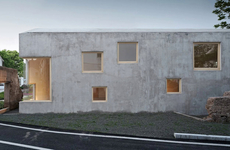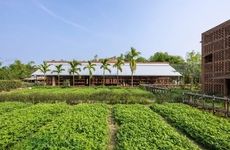
A.Len Rebuilds the House of Soviet Science and Culture
Jamie Danielle Munro — May 27, 2014 — Art & Design
References: a-len & designboom
The House of Soviet Science and Culture was mostly destroyed during the fighting that took place in Afghanistan beginning in the 1990s, and now architecture firm A.Len is moving into Kabul in order to restore the space.
The design will focus mainly on a central courtyard area, which is surrounded by a perforated wall to allow for sufficient airflow. Considering the temperatures that this area can rise to, it's important that most architectural designs take this heat into mind. Because this is a Russian structure in Afghanistan, Russian ornamentation will also be found throughout the design to pay tribute to the overall theme of the place. While this is just a concept by A.Len firm right now, the steps are being put in place for construction to start soon.
Photo Credits: designboom, a-len
The design will focus mainly on a central courtyard area, which is surrounded by a perforated wall to allow for sufficient airflow. Considering the temperatures that this area can rise to, it's important that most architectural designs take this heat into mind. Because this is a Russian structure in Afghanistan, Russian ornamentation will also be found throughout the design to pay tribute to the overall theme of the place. While this is just a concept by A.Len firm right now, the steps are being put in place for construction to start soon.
Photo Credits: designboom, a-len
Trend Themes
1. Perforated Architecture - Opportunity to incorporate designs with in-built natural cooling systems, could be applied to healthcare facilities, residential and commercial spaces in arid regions around the world.
2. Heritage Design Influence - Opportunity to infuse cultural references in design elements to preserve traditional aesthetics and connect with the local community, applicable to restoration and new build projects worldwide.
3. Cultural Infrastructure Development - Opportunity to lead diplomatic and political initiatives through designing and building cultural infrastructure that fosters dialogue, exchange and mutual understanding between diverse communities and nations.
Industry Implications
1. Architecture and Design - Firms should leverage best practices and local knowledge to create adaptive designs that blend heritage and innovative elements with efficiency and sustainability features, in order to attract clients from the public and private sectors.
2. Cultural Diplomacy - Organizations can facilitate diplomatic and cultural understanding by investing in infrastructure development, cultural exchanges, and education programs that enable dialogue and promote mutual respect and tolerance among diverse communities.
3. Construction and Engineering - Companies can utilize new technologies and sustainable materials to construct buildings that are cost-effective and energy-efficient, while also meeting the cultural and aesthetic requirements of the communities they serve.
4.5
Score
Popularity
Activity
Freshness























